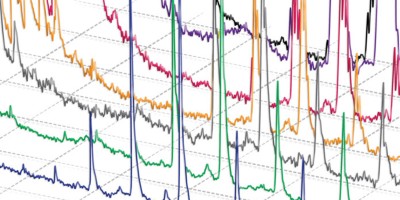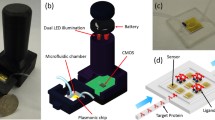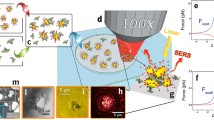Abstract
This protocol describes a signal-generation mechanism for the naked-eye detection of analytes at low concentrations with ELISA. The key step is to generate solutions of desired tonality by growing gold nanoparticles with a particular state of aggregation. This is accomplished by linking the growth of gold nanoparticles with the biocatalytic cycle of the enzyme label. The protocol adapts a conventional ELISA procedure with catalase-labeled antibodies. The enzyme consumes hydrogen peroxide, and then gold (III) ions are added to generate gold nanoparticles. The concentration of hydrogen peroxide dictates the state of aggregation of gold nanoparticles. This allows for the naked-eye detection of analytes by observing the generation of blue- or red-colored gold nanoparticle solutions. When coupled with conventional ELISA, this signal-generation procedure allows for the naked-eye detection of analytes within 1 h.



Similar content being viewed by others
References
Clark, M.F., Lister, R.M. & Barjoseph, M. ELISA techniques. Method Enzymol. 118, 742–766 (1986).
Pierangeli, S.S. & Harris, E.N. A protocol for determination of anticardiolipin antibodies by ELISA. Nat. Protoc. 3, 840–848 (2008).
Ambrosi, A., Airo, F. & Merkoci, A. Enhanced gold nanoparticle based ELISA for a breast cancer biomarker. Anal. Chem. 82, 1151–1156 (2010).
Brena, B.M. et al. ELISA as an affordable methodology for monitoring groundwater contamination by pesticides in low-income countries. Environ. Sci. Technol. 39, 3896–3903 (2005).
Kang, X.P. et al. Development of an ELISA-array for simultaneous detection of five encephalitis viruses. Virol. J. 9, 56 (2012).
Neely, E. et al. Development of a capture/enrichment sandwich ELISA for the rapid detection of enteropathogenic and enterohaemorrhagic Escherichia coli O26 strains. J. Appl. Microbiol. 97, 1161–1165 (2004).
Asensio, L., Gonzalez, I., Garcia, T. & Martin, R. Determination of food authenticity by enzyme-linked immunosorbent assay (ELISA). Food Control 19, 1–8 (2008).
Cuendet, M., Mesecar, A.D., DeWitt, D.L. & Pezzuto, J.M. An ELISA method to measure inhibition of the COX enzymes. Nat. Protoc. 1, 1915–1921 (2006).
Qu, W., Liu, Y., Liu, D., Wang, Z. & Jiang, X. Copper-mediated amplification allows readout of immunoassays by the naked eye. Angew. Chem. Int. Ed. 50, 3442–3445 (2011).
de la Rica, R. & Stevens, M.M. Plasmonic ELISA for the ultrasensitive detection of disease biomarkers with the naked eye. Nat. Nanotechnol. 7, 821–824 (2012).
Mei, Z.L. et al. Ultrasensitive one-step rapid visual detection of bisphenol A in water samples by label-free aptasensor. Biosens Bioelectron. 39, 26–30 (2013).
Zhou, Q.Q. et al. Development of gold nanoparticle-based rapid detection kit for melamine in milk products. J. Agric. Food Chem. 59, 12006–12011 (2011).
Yang, H. et al. A novel quantum dots-based point of care test for syphilis. Nanoscale Res. Lett. 5, 875–881 (2010).
Rodriguez-Lorenzo, L., de la Rica, R., Alvarez-Puebla, R.A., Liz-Marzan, L.M. & Stevens, M.M. Plasmonic nanosensors with inverse sensitivity by means of enzyme-guided crystal growth. Nat. Mater. 11, 604–607 (2012).
Engelbrekt, C. et al. Green synthesis of gold nanoparticles with starch–glucose and application in bioelectrochemistry. J. Mater. Chem. 19, 7839–7847 (2009).
Acknowledgements
M.M.S. thanks the Engineering and Physical Sciences Research Council and the European Research Council starting investigator grant 'Naturale' for funding. This research was supported by a Marie Curie Intra-European Fellowship within the 7th European Community Framework Programme (R.d.l.R.).
Author information
Authors and Affiliations
Contributions
R.d.l.R. conceived and designed the method and wrote the manuscript. M.M.S. supervised the work and revised the manuscript.
Corresponding authors
Ethics declarations
Competing interests
The authors declare no competing financial interests.
Supplementary information
Supplementary Figure 1
Generation of colored gold nanoparticle solutions at different final concentrations of hydrogen peroxide. Blue solutions can be obtained when the concentration of hydrogen peroxide in the growth solution decreases by as low as 50 nM. Lower decreases in the concentration of hydrogen peroxide were not assayed because it is extremely difficult to prepare hydrogen peroxide solutions with accurate concentration between 120 μM and 119.95 μM. Therefore the decrease in the concentration of hydrogen peroxide needed to obtain blue-colored nanoparticle solutions could be even lower than 50 nM. (PDF 533 kb)
Rights and permissions
About this article
Cite this article
de la Rica, R., Stevens, M. Plasmonic ELISA for the detection of analytes at ultralow concentrations with the naked eye. Nat Protoc 8, 1759–1764 (2013). https://doi.org/10.1038/nprot.2013.085
Published:
Issue Date:
DOI: https://doi.org/10.1038/nprot.2013.085
- Springer Nature Limited
This article is cited by
-
Paper-based genetic assays with bioconjugated gold nanorods and an automated readout pipeline
Scientific Reports (2022)
-
A colorimetric method for determination of the prostate specific antigen based on enzyme-free cascaded signal amplification via peptide-copper(II) nanoparticles
Microchimica Acta (2020)
-
In situ formation of fluorescent silicon-containing polymer dots for alkaline phosphatase activity detection and immunoassay
Science China Chemistry (2020)
-
Enzyme-amplified SERS immunoassay with Ag-Au bimetallic SERS hot spots
Nano Research (2020)
-
Enzyme-catalyzed Ag Growth on Au Nanoparticle-assembled Structure for Highly Sensitive Colorimetric Immunoassay
Scientific Reports (2018)





